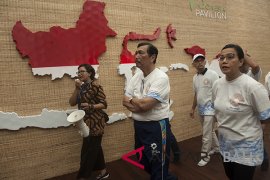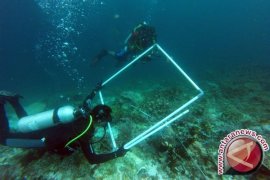The condition of coral reefs in the country had deteriorated slightly in late 2016, although it had improved steadily since 1993, Dirhamsyah, head of the Oceanography Research Center of LIPI, said here, Wednesday.
The deterioration was due to coral bleaching in 2015 and 2016 occurring in nearly all regions in the Indonesian waters.
El Nino triggered a rise in the water temperature, and this condition caused coral bleaching, he explained.
He warned that coral bleaching might occur more frequently due to climate change and global warming.
Other factors affecting the countrys coral reefs include destructive fishing activities using explosives, water pollution, and development activities in the coastal areas.
LIPI has released a report on the latest condition of Indonesian coral reefs in 2017.
Based on data from verification and analyses conducted in 108 locations and 1,064 stations across the Indonesian waters, it is reported that 6.39 percent of the countrys coral reefs are still in excellent condition, 23.40 percent in good condition, 35.06 percent in moderate condition, and 35.15 percent in bad condition.
The measurement of the condition is based on the living coral reef coverage percentage: the excellent category has coverage of 76-100 percent; good, at 51-75 percent; moderate, at 26-50 percent; and bad, at 0-25 percent.
Suharsono, a senior researcher at the LIPI Oceanography Research Center, explained that the Indonesian coral reefs extend from the Sabang waters in Indonesias westernmost province of Aceh to the Merauke waters in the easternmost province of Papua.
The highest distribution concentration is in the central and eastern Indonesian waters including the waters of Sulawesi, Papua, Nusa Tenggara, and Maluku, which is also called the coral triangle core.
Based on the latest satellite imagery mapping, Indonesias coral reefs are spread across an area of 25 thousand square kilometers, or around 10 percent of the worlds coral reef measuring 284,300 square kilometers, and constituting about 34 percent of the coral reefs in the coral triangle region spanning 73 thousand square kilometers, according to a report of COREMAP-CTI LIPI in 2016.
"As the center of the worlds coral triangle, Indonesia has the highest number of coral reef species on the planet -- 569 species from 82 families and 15 tribes -- out of the total 845 coral reef species in the world," he said.
He cited as an example that Indonesia has 94 species of Acropora corals (Acropora sp), or 70 percent of the 124 found across the world. Caribbean has only three species.
With regard to the Fungiidae family, the world has 43 species, and 41 of them are in Indonesia, or around 90 percent.
Among endemic species of coral reefs found in Indonesia are Acropora suharsonoi, Isopora togeanensis, Acropora desalwi, Indophyllia macasserensis, and Euphyllia baliensis.
Moreover, Indonesia has a limited distribution of coral reefs that are also found in the Indian and Pacific oceans, such as Acropora kasuarini, Acropora rudis, and Acropora turtuosa.(*)





